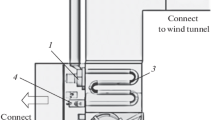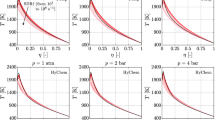Abstract
Airworthiness standards require a fire resistance demonstration for aircraft or helicopter engines to obtain a type certificate. This demonstration relies on tests performed with prototype engine parts in the late stages of the development. In hardest tests, a kerosene standardized flame with imposed burnt gas temperature and heat flux is placed next to the engine casing during a given time. The aim of this work is to provide a better characterization of a kerosene/air certification burner in order to reach a better understanding of the thermal environment during fire tests. To this purpose, Large-Eddy Simulation (LES) of the certification burner is carried out. Spray combustion, forced convection on walls and conduction in the solid parts of the burner are coupled to achieve a detailed description of heat transfer. In a first place, physical aspects involved inside the burner in an adiabatic case are described. Then, differences that exist with a conjugate convective and conductive heat transfer case are analyzed. To a larger extent, the aim is to have a better characterization of the flow impinging the casing and to progress on fire test modeling so as to minimize the risks of test failure.



















Similar content being viewed by others
References
Certification specifications for engines. Annex to ED decision 2010/015/R amendment 3 european aviation safety agency (2010)
ISO 2685:1998: Aircraft - environmental conditions and test procedures for airborne equipment - resistance to fire in designated fire zones. Technical report, The International Organization for Standardization (ISO) (1998)
US Department of Transportation. Powerplant installation and propulsion system component fire protection test methods, standards and criteria. Technical report, Federal Aviation Administration: Advisory Circular (AC) (1990)
Ochs, R.I.: Design and Analysis of the Federal Aviation Administration Next Generation Fire Test Burner. PhD thesis at Rutgers University, USA (2013)
Le Neve, S.: AC20-135/ ISO 2685, Fire tests on components used in fire zones. Comparison of gas burner to oil burner. Proceedings of the FAA Materials Meeting, Atlantic City (2008)
Tranchard, P., Samyn, F., Duquesne, S., Thomas, M., Estèbe, B., Montès, J.L., Bourbigot, S.: Fire behaviour of carbon fibre epoxy composite for aircraft: Novel test bench and experimental study. J. Fire Sci. 33(3), 247–266 (2015)
Kao, Y.H., Tambe, S.B., Ochs, R., Summer, S., Jeng, S.M.: Experimental study of the burner for FAA fire test: Nexgen burner. Fire Mater. 41(7), 898–907 (2017)
Neely, A., Ireland, P.: Pilot study to investigate novel experimental and theoretical fire-event modelling techniques. AIAA, 37th ASME, vol. 99–0326 (1999)
Sikoutris, D.E., Vlachos, D.E., Kostopoulos, V., Jagger, S., Ledin, S.: Fire burnthrough response of CFRP aerostructures. Numerical investigation and experimental verification. Appl. Compos. Mater. 19(2), 141–159 (2012)
Grange, N., Chetehouna, K., Gascoin, N., Senave, S.: Numerical investigation of the heat transfer in an aeronautical composite material under fire stress. Fire Saf. J. 80, 56–63 (2016)
Moureau, V., Domingo, P., Vervisch, L.: Design of a massively parallel CFD code for complex geometries. C. R. Mécanique 339, 141–148 (2011)
Pierce, C.D., Moin, P.: Progress-variable approach for large eddy simulation of non-premixed turbulent combustion. J. Fluid Mech. 504, 73–97 (2004)
Chorin, A.J.: Numerical solution of the Navier-Stokes equations. Math. Comput. 22(104), 745–762 (1968)
Kim, J., Moin, P.: Application of a fractional-step method to incompressible navier-stokes equations. J. Comput. Phys. 59(2), 308–323 (1985)
Kraushaar, M.: Application of the Compressible and Low-Mach Number Approaches to Large-Eddy Simulation of Turbulent Flows in Aero-Engines. FRANCE, PhD thesis at CERFACS of Toulouse (2011)
Edwards, T., Maurice, L.Q.: Surrogate mixtures to represent complex aviation and rocket fuels. J. Propul. Power 17(2), 461–466 (2001)
Orain, M., Baranger, P., Ledier, C., Apeloig, J., Grisch, F.: Fluorescence spectroscopy of kerosene vapour at high temperatures and pressures: potential for gas turbines measurements. Appl. Phys. B 116(3), 729–745 (2014)
Rachner, M.: Die Stoffeigenschaften von Kerosin Jet A-1. DLR-Mitteilung 152, 98–01 (1998). [in German]
Vovelle, C., Delfau, J.L., Reuillon, M.: Formation of aromatic hydrocarbons in decane and kerosene flames at reduced pressure. Soot Formation Combust 59, 50–65 (1994)
Riesmeier, E., Honnet, S., Peters, N.: Flamelet modeling of pollutant formation in a gas turbine combustion chamber using detailed chemistry for a kerosene model fuel. J. Eng. Gas Turbines Power. 126(4), 899–905 (2004)
Balès-Guéret, C., Cathonnet, M., Boettner, J.C., Gaillard, F.: Experimental study and kinetic modeling of higher hydrocarbon oxidation in a jet-stirred flow reactor. Energy Fuels 6(2), 189–194 (1992)
Elliott, L., Ingham, D.B., Kyne, A.G., Mera, N.S., Pourkashanian, M., Whittaker, S.: Reaction mechanism reduction and optimisation for modelling aviation fuel oxidation using standard and hybrid genetic algorithms. Comput. Chem. Eng. 30 (5), 889–900 (2006)
Slavinskaya, N.A., Zizin, A., Aigner, M.: On model design of a surrogate fuel formulation. J. Eng. Gas Turbines Power 132(11), 111501 (2010)
Anand, K., Ra, Y., Reitz, R.D., Bunting, B.: Surrogate model development for fuels for advanced combustion engines. Energy Fuels 25(4), 1474–1484 (2011)
Schulz, W.D.: Oxidation products of a surrogate JP-8 fuel. Preprints-american Chemical Society. Div. Pet. Chem. 37(2), 383–392 (1992)
Delfau, J.L., Bouhria, M., Reuillon, M., Sanogo, O., Akrich, R., Vovelle, C.: Experimental and computational investigation of the structure of a sooting decane-O2-Ar flame. Proc. Combust. Inst. 23, 1567–1572 (1991)
Cathonnet, M., Balès-Guéret, C., Chakir, A., Dagaut, P., Boettner, J.C., Schultz, J.L.: On the Use of Detailed Chemical Kinetics to Model Aeronautical Combustors Performances. Proc. of the Third European Propulsion Forum, EPF91, ONERA Paris, AAAF (1992)
Dagaut, P.: On the kinetics of hydrocarbons oxidation from natural gas to kerosene and diesel fuel. Phys. Chem. Chem. Phys. 4(11), 2079–2094 (2002)
Luche, J., Reuillon, M., Boettner, J.C., Cathonnet, M.: Reduction of large detailed kinetic mechanisms: application to kerosene/air combustion. Combust. Sci. Technol. 176(11), 1935–1963 (2004)
Franzelli, B., Riber, E., Sanjosé, M., Poinsot, T.: A two-step chemical scheme for kerosene-air premixed flames. Combust. Flame 157(7), 1364–1373 (2010)
Bénard, P., Moureau, V., Lartigue, J., D’Angelo, Y.: Large-eddy Simulation of a hydrogen enriched methane/air meso-scale combustor. Int. J. Hydrog. Energy 42 (4), 2397–2410 (2017)
Boussinesq, J.: Théorie de l’écoulement tourbillonant. Mem. Pres. Acad. Sci. 42, 23–46 (1877)
Germano, M., Piomelli, U., Moin, P., Cabot. W.H.: A dynamic subgrid-scale eddy viscosity model. Phys. Fluids A: Fluid Dyn. (1989-1993) 3(7), 1760–1765 (1991)
Butler, T.D., O’Rourke, P.J.: A numerical method for two dimensional unsteady reacting flows. Proc. Combust. Inst. 16, 1503–1515 (1977)
Légier, J.P., Poinsot, T., Veynante, D.: Dynamically thickened flame les model for premixed and nonpremixed turbulent combustion. Proc. of the Summer Program, 157–168 (2000)
Charlette, F., Meneveau, C., Veynante, D.: A power-law flame wrinkling model for LES of premixed turbulent combustion Part I: non-dynamic formulation and initial tests. Combust. Flame 131(1-2), 159–180 (2002)
Guédot, L.: Développement de méthodes numériques pour la caractérisation des grandes structures tourbillonnaires dans les brûleurs aéronautiques: application aux systèmes d’injection multi-points. PhD thesis at Institut National des Sciences appliquées de Rouen, France (2015)
Schiller, L., Naumann, Z.: A drag coefficient correlation. Vdi Zeitung 77(318), 51 (1935)
Spalding, D.B.: The combustion of liquid fuels. Proc. Combust. Inst. 4, 847–864 (1953)
Abramzon, B., Sirignano, W.: Droplet vaporization model for spray combustion calculations. Int. J. Heat Mass Transfer 32(9), 1605–1618 (1989)
Kuo, K.: Principles of combustion. Wiley, Hoboken (1986)
Sirignano, W.A.: Fluid dynamics and transport of droplets and sprays. Cambridge University Press, Cambridge (2010)
Guédot, L., Lartigue, G., Moureau, V.: Modeling and analysis of the interactions of coherent structures with a spray flame in a swirl burner. Turbul. Interactions 135, 15–26 (2015)
Farcy, B., Vervisch, L., Domingo, P.: Large eddy simulation of selective non-catalytic reduction (SNCR): a downsizing procedure for simulating nitric-oxide reduction units. Chem. Eng. Sci. 139, 285–303 (2016)
Esclapez, L., Ma, P.C., Mayhew, E., Xu, R., Stouffer, S., Lee, T., Ihme, M.: Fuel effects on lean blow-out in a realistic gas turbine combustor. Combust. Flame 181, 82–99 (2017)
Okong’o, N.A., Bellan, J.: Consistent large-eddy simulation of a temporal mixing layer laden with evaporating drops. Part 1: direct numerical simulation, formulation and a priori analysis. J. Fluid Mech. 499, 1–47 (2004)
Bini, M., Jones, W.: Particle acceleration in turbulent flows: a class of nonlinear stochastic models for intermittency. Phys. Fluids 19(3), 1–9 (2007)
Hannebique, G., Sierra, P., Riber, E., Cuenot, B.: Large-eddy simulation of reactive two-phase flow in an aeronautical multipoint burner. Flow Turbul. Combust. 90(2), 449–469 (2013)
Sanjosé, M., Senoner, J.M., Jaegle, F., Cuenot, B., Moreau, S., Poinsot, T.: Fuel injection model for euler-euler and euler-lagrange large-eddy simulations of an evaporating spray inside an aeronautical combustor. Int. J. Multiphase Flow 37(5), 514–529 (2011)
Fourier, J.: Théorie analytique de la chaleur. Chez Firmin Didot, père et fils (1822)
Malandain, M., Maheu, N., Moureau, V.: Optimization of the deflated Conjugate Gradient algorithm for the solving of elliptic equations on massively parallel machines. J. Comput. Phys. 238, 32–47 (2012)
Luo, J., Razinsky, E.H.: Conjugate heat transfer analysis of a cooled turbine vane using the v2f turbulence model. J. Turbomach. 129(4), 773–781 (2007)
He, L., Oldfield, M.L.G.: Unsteady conjugate heat transfer modeling. J. Turbomach. 133(3), 031022 (2011)
York, W.D., Leylek, J.H.: Three-dimensional conjugate heat transfer simulation of an internally-cooled gas turbine vane. ASME Turbo Expo 2003, collocated with the 2003 International Joint Power Generation Conference, GT2003-38551, pp. 351–360 (2003)
Duchaine, F., Corpron, A., Pons, L., Moureau, V., Nicoud, F., Poinsot, T.: Development and assessment of a coupled strategy for conjugate heat transfer with large eddy simulation: application to a cooled turbine blade. Int. J. Heat Fluid Flow. 30(6), 1129–1141 (2009)
Jauré, S., Duchaine, F., Staffelbach, G., Gicquel, L.Y.M.: Massively parallel conjugate heat transfer methods relying on large eddy simulation applied to an aeronautical combustor. Comput. Sci. Discov. 6(1), 015008 (2013)
Florenciano, J.L., Bruel, P.: LES Fluid-solid coupled calculations for the assessment of heat transfer coefficient correlations over multi-perforated walls. Aerosp. Sci. Technol. 53, 61–73 (2016)
Scholl, S., Verstraete, T., Duchaine, F., Gicquel, L.: Conjugate heat transfer of a rib-roughened internal turbine blade cooling channel using large eddy simulation. Int. J. Heat Fluid Flow. 61, 650–664 (2016)
Misdariis, A., Vermorel, O., Poinsot, T.: LES Of knocking in engines using dual heat transfer and two-step reduced schemes. Combust. Flame 162(11), 4304–4312 (2015)
Giles, M.B.: Stability analysis of numerical interface conditions in fluid-structure thermal analysis. Int. J. Numer. Methods Fluids 25(4), 421–436 (1997)
Felippa, C.A., Park, K.C., Farhat, C.: Partitioned analysis of coupled mechanical systems. Comput. Methods Appl. Mech. Eng. 190(24), 3247–3270 (2001)
Duchaine, F., Jauré, S., Poitou, D., Quémerais, E., Staffelbach, G., Morel, T., Gicquel, L.: Analysis of high performance conjugate heat transfer with the OpenPALM coupler. Comput. Sci. Discov. 8(1), 015003 (2015)
Shapiro, R.: Linear filtering. Math. Comput. 29(132), 1094–1097 (1975)
Maheu, N., Moureau, V., Domingo, P.: Large-eddy simulations of flow and heat transfer around a low-Mach number turbine blade. Proc. of the Summer Program, 137–146 (2012)
Nguyen, P.D., Moureau, V., Vervisch, L., Perret, N.: A massively parallel solution strategy for efficient thermal radiation simulation. J. Phys. Conf. Ser. 369(1), 012017 (2012)
Acknowledgements
This work was granted access to the HPC resources from CINES (Centre Informatique National de l’Enseignement Superieur), from IDRIS (Institut du Developpement et des Ressources en Informatique Scientifique) and from TGCC-CEA under the allocations x20172b6880 made by GENCI (Grand Equipement National de Calcul Intensif). It was also granted CPU time by CRIANN under the allocation 2012006.
Author information
Authors and Affiliations
Corresponding author
Ethics declarations
Conflict of interests
The authors declare that they have no conflict of interest.
Additional information
Publisher’s Note
Springer Nature remains neutral with regard to jurisdictional claims in published maps and institutional affiliations.
Rights and permissions
About this article
Cite this article
Boulet, L., Bénard, P., Lartigue, G. et al. Modeling of Conjugate Heat Transfer in a Kerosene/Air Spray Flame used for Aeronautical Fire Resistance Tests. Flow Turbulence Combust 101, 579–602 (2018). https://doi.org/10.1007/s10494-018-9965-8
Received:
Accepted:
Published:
Issue Date:
DOI: https://doi.org/10.1007/s10494-018-9965-8




